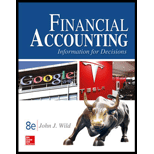
Financial Accounting: Information for Decisions
8th Edition
ISBN: 9781259533006
Author: John J Wild
Publisher: McGraw-Hill Education
expand_more
expand_more
format_list_bulleted
Textbook Question
Chapter 1, Problem 3DQ
Identify four kinds of external users and describe how they use accounting information.
Expert Solution & Answer
Want to see the full answer?
Check out a sample textbook solution
Students have asked these similar questions
Need answer the general accounting question
What is the amount of the shareholders equity?
Which principle dictates that a business should report revenue when it is earned and expenses when they are incurred? A. Matching Principle B. Revenue Recognition Principle C. Cost Principle D. Accrual Principle Help
Chapter 1 Solutions
Financial Accounting: Information for Decisions
Ch. 1 - Prob. 1DQCh. 1 - Technology is increasingly used to process...Ch. 1 - Identify four kinds of external users and describe...Ch. 1 - What are at least three questions business owners...Ch. 1 - Prob. 5DQCh. 1 - Describe the internal role of accounting for...Ch. 1 - Identify three types of services typically offered...Ch. 1 - Prob. 8DQCh. 1 - Why is accounting described as a service activity?Ch. 1 - What are some accounting-related professions?
Ch. 1 - Prob. 11DQCh. 1 - Prob. 12DQCh. 1 - What does the concept of objectivity imply for...Ch. 1 - Prob. 14DQCh. 1 - Prob. 15DQCh. 1 - Prob. 16DQCh. 1 - Define (a) assets, (b) liabilities, (c) equity,...Ch. 1 - Prob. 18DQCh. 1 - Prob. 19DQCh. 1 - What do accountants mean by the term revenue?Ch. 1 - Prob. 21DQCh. 1 - Prob. 22DQCh. 1 - Prob. 23DQCh. 1 - Prob. 24DQCh. 1 - Prob. 25DQCh. 1 - Prob. 26DQCh. 1 - Prob. 27DQCh. 1 - Define and explain return on assets.Ch. 1 - Define return and risk. Discuss the trade-off...Ch. 1 - Prob. 30DQCh. 1 - Prob. 31DQCh. 1 - Prob. 32DQCh. 1 - Prob. 33DQCh. 1 - Prob. 34DQCh. 1 - Choose from the following term or phrase a through...Ch. 1 - Prob. 2QSCh. 1 - Prob. 4QSCh. 1 - Prob. 5QSCh. 1 - Prob. 6QSCh. 1 - Prob. 7QSCh. 1 - Applying the accounting equation A1 Use the...Ch. 1 - Prob. 9QSCh. 1 - Prob. 10QSCh. 1 - Prob. 11QSCh. 1 - Prob. 12QSCh. 1 - Prob. 13QSCh. 1 - Prob. 14QSCh. 1 - Prob. 15QSCh. 1 - Prob. 16QSCh. 1 - Prob. 1ECh. 1 - Identifying accounting users and uses C2 Part A....Ch. 1 - Prob. 3ECh. 1 - Prob. 6ECh. 1 - Prob. 7ECh. 1 - Determine the missing amount from each of the...Ch. 1 - Prob. 9ECh. 1 - Prob. 10ECh. 1 - Prob. 11ECh. 1 - Prob. 12ECh. 1 - Prob. 13ECh. 1 - Prob. 14ECh. 1 - Prob. 15ECh. 1 - Use the information in Exercise 1-15 to prepare an...Ch. 1 - Prob. 17ECh. 1 - Prob. 18ECh. 1 - Prob. 19ECh. 1 - Prob. 20ECh. 1 - Prob. 21ECh. 1 - Prob. 1PSACh. 1 - Prob. 2PSACh. 1 - Prob. 3PSACh. 1 - Prob. 4PSACh. 1 - Prob. 5PSACh. 1 - Prob. 6PSACh. 1 - Prob. 8PSACh. 1 - Prob. 9PSACh. 1 - Prob. 10PSACh. 1 - Prob. 11PSACh. 1 - Prob. 12PSACh. 1 - Prob. 13PSACh. 1 - Prob. 14PSACh. 1 - Prob. 1PSBCh. 1 - Prob. 3PSBCh. 1 - Prob. 4PSBCh. 1 - Prob. 5PSBCh. 1 - Prob. 6PSBCh. 1 - Prob. 7PSBCh. 1 - Prob. 8PSBCh. 1 - Prob. 9PSBCh. 1 - Prob. 10PSBCh. 1 - Prob. 11PSBCh. 1 - Prob. 12PSBCh. 1 - Prob. 13PSBCh. 1 - Prob. 14PSBCh. 1 - Prob. 1SPCh. 1 - Prob. 2BTNCh. 1 - Prob. 7BTNCh. 1 - Prob. 9BTN
Knowledge Booster
Learn more about
Need a deep-dive on the concept behind this application? Look no further. Learn more about this topic, accounting and related others by exploring similar questions and additional content below.Similar questions
- At the beginning of the year, Alpine Corp.'s liabilities equal $95,000. During the year, assets increased by $25,000, and at the end of the year, assets equal $270,000. Liabilities increased by $40,000 during the year. Calculate the amount of equity at the beginning of the year. A. $250,000 B. $150,000 C. $100,000 D. $175,000arrow_forwardCan you help me with accounting questionsarrow_forwardA product has a selling price of $63, variable costs of $55, and fixed costs are $72,000. How many units must be sold to break even? A) 3,000 B) 5,000 C) 2,500 D) 9,000 correct answerarrow_forward
arrow_back_ios
SEE MORE QUESTIONS
arrow_forward_ios
Recommended textbooks for you
 Intermediate Accounting: Reporting And AnalysisAccountingISBN:9781337788281Author:James M. Wahlen, Jefferson P. Jones, Donald PagachPublisher:Cengage Learning
Intermediate Accounting: Reporting And AnalysisAccountingISBN:9781337788281Author:James M. Wahlen, Jefferson P. Jones, Donald PagachPublisher:Cengage Learning Accounting Information SystemsAccountingISBN:9781337619202Author:Hall, James A.Publisher:Cengage Learning,
Accounting Information SystemsAccountingISBN:9781337619202Author:Hall, James A.Publisher:Cengage Learning,

Intermediate Accounting: Reporting And Analysis
Accounting
ISBN:9781337788281
Author:James M. Wahlen, Jefferson P. Jones, Donald Pagach
Publisher:Cengage Learning

Accounting Information Systems
Accounting
ISBN:9781337619202
Author:Hall, James A.
Publisher:Cengage Learning,
ACCOUNTING BASICS: Debits and Credits Explained; Author: Accounting Stuff;https://www.youtube.com/watch?v=VhwZ9t2b3Zk;License: Standard Youtube License